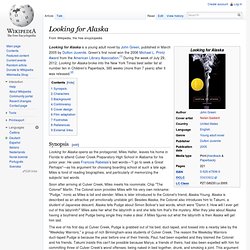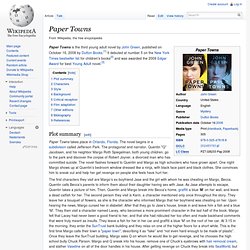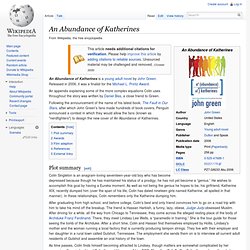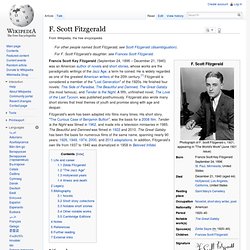

John Green (author) John Michael Green (born August 24, 1977) is an American author of young adult fiction and a YouTube video blogger and creator of online educational videos.

He won the 2006 Printz Award for his debut novel, Looking for Alaska,[1] and his most recent novel, The Fault in Our Stars debuted at number 1 on The New York Times Best Seller list in January 2012.[2] Green was born in Indianapolis to Mike and Sydney Green[3] and his family moved three weeks after he was born[4] to Orlando, Florida.[5] He attended Lake Highland Preparatory School and Indian Springs School (which he later used as the main setting for Looking for Alaska),[6] a boarding and day school outside of Birmingham, Alabama and graduated from Kenyon College in 2000 with a double major in English and Religious Studies.
He has spoken about being bullied as a teenager and how it made life miserable for him.[7] Looking for Alaska. Synopsis[edit] Looking for Alaska opens as the protagonist, Miles Halter, leaves his home in Florida to attend Culver Creek Preparatory High School in Alabama for his junior year.

He uses Francois Rabelais’s last words—"I go to seek a Great Perhaps"—as his argument for choosing boarding school at such a late age. Miles is fond of reading biographies, and particularly of memorizing the subjects' last words. Soon after arriving at Culver Creek, Miles meets his roommate, Chip "The Colonel" Martin. The Colonel soon provides Miles with his very own nickname: "Pudge," ironic as Miles is tall and slender. The eve of his first day at Culver Creek, Pudge is grabbed out of his bed, duct-taped, and tossed into a nearby lake by the "Weekday Warriors," a group of rich Birmingham-area students of Culver Creek. Alaska sets Pudge up with a girl, Lara. Paper Towns. Plot summary[edit] The first characters they visit are Margo’s ex-boyfriend Jase and the girl with whom he was cheating on Margo, Becca.

Quentin calls Becca's parents to inform them about their daughter having sex with Jase. As Jase attempts to escape, Quentin takes a picture of him. Then, Quentin and Margo break into Becca's home, graffiti a blue ‘M’ on her wall, and leave a dead catfish for her. The second person they visit is Karin, a character mentioned only once throughout the story. Margo and Q return to their homes close to the time they are supposed to be getting up in the morning to go to school. Eventually the clues lead Q to believe that Margo may be hiding out (or buried) in one of the many abandoned subdivision projects around Orlando; what Q’s mother likes to call "pseudodivisions". Characters[edit] Quentin “Q” Jacobsen- The protagonist and narrator of the story. Ben Starling- He is one of Quentin's best friends.
The Fault in Our Stars. Plot[edit] Hazel explains the magnificence of An Imperial Affliction: It is a novel about a girl named Anna who has cancer, and it's the only account she's read of living with cancer that matches her experience.

An Abundance of Katherines. An appendix explaining some of the more complex equations Colin uses throughout the story was written by Daniel Biss, a close friend to Green.

Following the announcement of the name of his latest book, The Fault in Our Stars, after which John Green's fans made hundreds of book covers, Penguin announced a contest in which they would allow the fans (known as "nerdfighters") to design the new cover of An Abundance of Katherines. Plot summary[edit] Colin Singleton is an anagram-loving seventeen-year-old boy who has become depressed because though he has maintained his status of a prodigy, he has not yet become a “genius.” He wishes to accomplish this goal by having a Eureka moment. F. Scott Fitzgerald. Francis Scott Key Fitzgerald (September 24, 1896 – December 21, 1940) was an American author of novels and short stories, whose works are the paradigmatic writings of the Jazz Age, a term he coined.

The Great Gatsby. Fitzgerald—inspired by the parties he had attended while visiting Long Island's north shore—began planning the novel in 1923, desiring to produce, in his words, "something new—something extraordinary and beautiful and simple and intricately patterned.

"[3] Progress was slow, with Fitzgerald completing his first draft following a move to the French Riviera in 1924. His editor, Maxwell Perkins, felt the book was too vague and convinced the author to revise over the next winter. Fitzgerald was ambivalent about the book's title, at various times wishing to re-title the novel Trimalchio in West Egg. First published by Scribner's in April 1925, The Great Gatsby received mixed reviews and sold poorly; in its first year, the book sold only 20,000 copies. Historical context[edit] Set on the prosperous Long Island of 1922, The Great Gatsby provides a critical social history of America during the Roaring Twenties within its narrative.